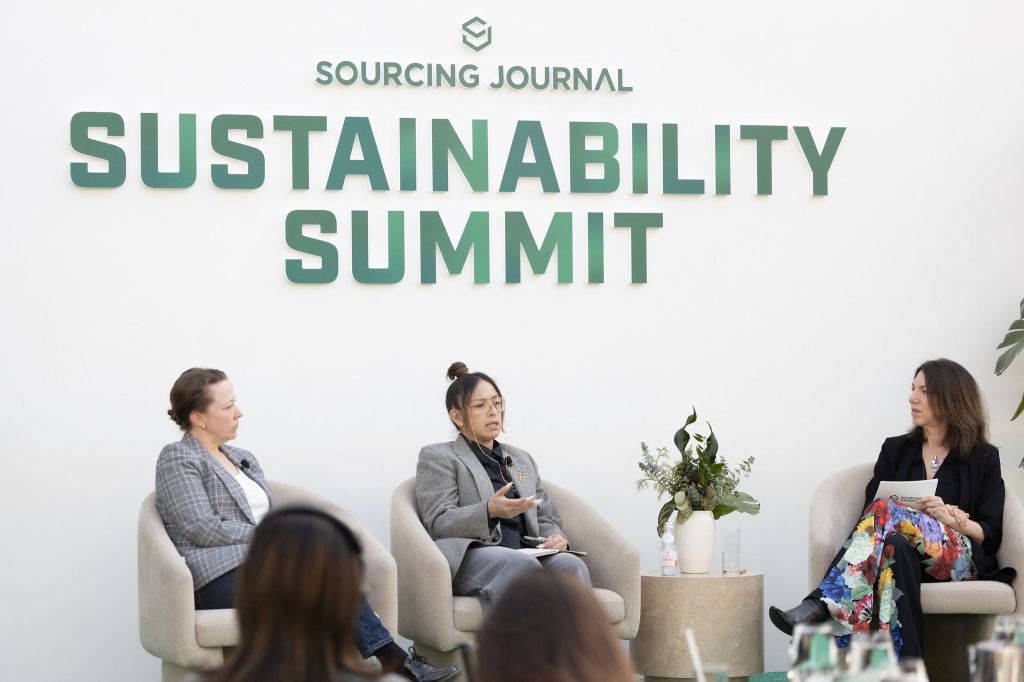Physical Address
304 North Cardinal St.
Dorchester Center, MA 02124
Physical Address
304 North Cardinal St.
Dorchester Center, MA 02124

Circularity is moving past the proof of concept stage, but work is still needed to advance adoption of recycled materials.
In a panel at Sourcing Journal’s Sustainability Summit, moderated by Lauren Parker, director of Sourcing Journal and Fairchild Studio, speakers from Accelerating Circularity and Lenzing discussed their circular collaborations and the role that transparency plays in sustainability.
Accelerating Circularity was founded in 2019 and completed its first system trials in 2021 in the U.S. and then EU. Together with about 70 partners, it tested pilots for different processes and technologies for steps like collection, sortation and recycling across the supply chain. A few years later, materials collected during the trials have been turned in merchandise sold at major retailers like Target. For instance, Wrangler used 26 percent mechanically recycled cotton—a 50-50 blend of post-consumer and post-industrial waste—in men’s jeans that launched online at Walmart earlier this year.
“We’ve demonstrated that the basic components of the circular system exist,” said Sarah Coulter, Americas program director at Accelerating Circularity. “Now, how do we take those materials—those circular fibers, yarns and fabrics—and really, truly make them mainstream?”
Coulter added that Accelerating Circularity is now focused on overcoming the “major roadblocks” in the way of circularity. Among the forces challenging recycled material uptake are regulations. She has seen the Uyghur Forced Labor Prevention Act (UFLPA) cause a pullback on recycled cotton. And in the EU, REACH (Registration, Evaluation, Authorisation and Restriction of Chemicals) presents complications for recycling. “We just don’t have enough data about how these chemicals turn up in regenerated fibers and how absolutist the enforcement and regulation around that will be,” said Coulter.
As a founding member of Accelerating Circularity, Lenzing Group is also focused on what happens to products at end of life, and it has collaborated with the organization on recycling solutions such as Lenzing’s Refibra technology that incorporates textile waste into new wood-based fibers.
Sharon Perez, senior business development manager at Lenzing Group, noted that there are three potential ways to design with a product’s end of life in mind: circularity, degradation and durability. On the circularity front, Lenzing is working with a VF Corp. brand and its vertical supplier to use Refibra technology to turn textile waste from the brand’s streams into new yarns and then garments.
Lenzing’s wood-based fibers—including its Tencel-branded lyocell and modal and its Ecovero viscose—are biodegradable, but Perez noted that typically fashion is made of multiple materials. Achieving biodegradable footwear is even more complex due to its numerous components. In a collaboration with Ortholite, the insole maker’s compostable Cirql foam was lined with 100 percent Tencel lyocell to create a biodegradable shoe.
Lastly, circular design can also be focused on longevity, which Perez explained Carhartt does well, with durable products and services like DIY repair kits. The workwear brand launched a Tencel range last year.
Focusing on end of life, Accelerating Circularity is conducting a “material flow” study that will look at where garments land at the close of their lifecycles. The organization is also building tools to help companies “be better stewards of those products,” said Coulter.
Visibility plays a key role in enabling circular systems. Traceability and transparency are often used interchangeably, but the panelists pointed out the terms’ distinct meanings.
Transparency is the overarching concept of disclosing information. “The principle of transparency is really about an honest accounting of really the most relevant information that your stakeholder needs to know, and how you present that in an open, honest way,” said Coulter. “And that doesn’t necessarily mean just about your supply chain. It’s about anything about your business that your stakeholders need to know.”
On the transparency front, the EU’s Ecodesign for Sustainable Products Regulation is introducing digital product passports (DPPs), which will require companies to make product information—including details on materials and recyclability—available to customers digitally. Coulter noted that while some see DPPs as the “holy grail,” it may not be a cure-all for circularity struggles. She added that current product information is often inaccurate, which may not be addressed through these digital solutions, and incorporating DPPs as a new element to products must include considerations of how these components will be dealt with at end of life.
Traceability falls under transparency, and is specifically about being able to map materials’ movement throughout the supply chain—whether through paper, physical markers or other solutions.
Transparency plays out at Lenzing with a three-pronged approach. Fiber identification technology can validate whether products—including yarns, textiles and finished goods—have genuine Lenzing fibers. A licensing platform, called E-Branding Services, further helps certify the fibers. Rounding out the trio is a traceability platform that uses digital coins to track chain of custody.
Proving authenticity allows Lenzing and its partners to differentiate its fibers from generic versions that do not have the same sustainability profiles. For instance, Ecovero viscose uses half the water and emissions compared to generic viscose.
“Transparency means an openness to everyone who comes into contact with our fibers,” said Perez. “We also believe that it’s the first step into a sustainable textile industry.”